



Jacobs. A world where you can.



As climate change threatens water security around the world, more communities are turning to water reuse as a resilient water supply solution and embracing the OneWater principle that all water has value. Jacobs has been supporting clients with water reuse programs for decades, beginning with the first applications of advanced wastewater treatment technologies in the 1960s. We provide our clients with a full range of services, from water reuse feasibility studies to design, construction and operations.



We’ve provided design-build services to the water sector for over 25 years and delivered more than 150 projects. We offer fully integrated design-build and design-build-operate capabilities to tackle the most complex water challenges and work in close collaboration with our clients.



For more than 30 years, Jacobs has been responsible for planning and implementing Lead and Copper Rule-related strategies which protect millions of people in the U.S. and Canada. Our work includes enhanced water quality monitoring strategies, sampling plan development, harvested pipe-scale analysis, lead service line inventories and replacement plans, corrosion control studies and the incorporation of equity and environmental justice considerations into compliance programs.



A curated selection of some of the top-listened to and trending podcast episodes from our popular If/When podcast series.



As a purpose-led company, we know we have a pivotal role to play in addressing the climate emergency. We consider this not only good business, but our duty to channel our technology-enabled expertise and capabilities toward benefitting people and the planet.



We work in partnership, delivering some of the most challenging, diverse and innovative projects and programs globally across multiple sectors. We integrate complex interfaces across planning, procurement and delivery to help unlock better social, environmental and economic outcomes from mega and giga projects.



As our clients navigate the digital transformation and growing cyber risks, we have positioned ourselves at the forefront of this growth, adding digital capabilities, products and tools to serve a growing set of customers.



Sit down with our visionary team of thinkers, dreamers and doers to see what a day in the life is like.



Together with our visionary partner, PA Consulting, we're establishing our position in high end advisory services, creating a springboard to expand in high value offerings beyond the core.


At Jacobs, we're challenging today to reinvent tomorrow by solving the world's most critical problems for thriving cities, resilient environments, mission-critical outcomes, operational advancement, scientific discovery and cutting-edge manufacturing, turning abstract ideas into realities that transform the world for good. With approximately $16 billion in annual revenue and a talent force of more than 60,000, Jacobs provides a full spectrum of professional services including consulting, technical, scientific and project delivery for the government and private sector.



The only certainty about the future is uncertainty. Resilience is an attribute of a smarter planet, and requires planning and adapting ahead of potential threats. We help our clients survive, recover, adapt and thrive.



Jacobs is working to help clients across the United States secure federal funding for projects that make our cities and communities more connected and sustainable. Working hand-in-hand with clients from coast to coast and everywhere in between, Jacobs develops bold, innovative solutions to address the nation’s toughest challenges.



Now more than ever, we appreciate the hard work, sacrifice and dedication of the medical profession in ensuring the health and safety of our communities.



Together, we are stronger. Together, we can transform the future.



Stories that capture our partnerships and innovative impact for a more connected, sustainable world


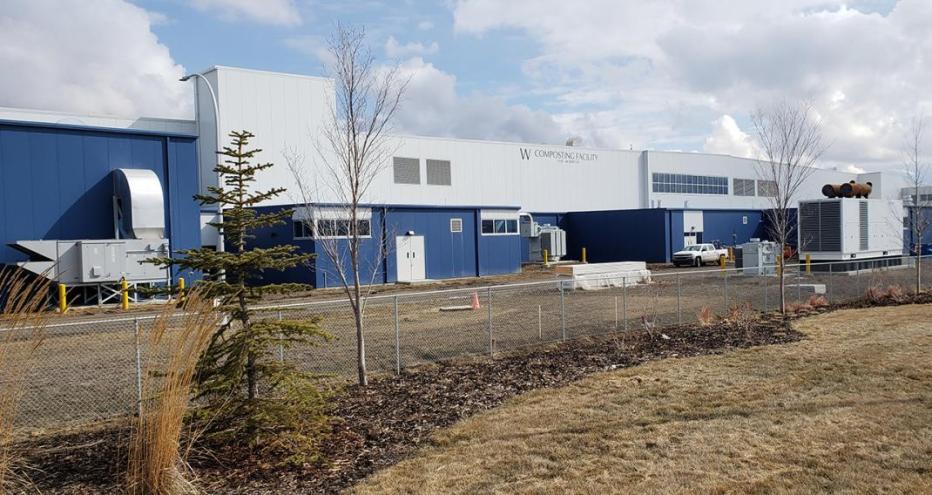
A significant source of greenhouse gas (GHG) emissions, contributing to global climate change, are the emissions resulting from the decomposition of organic waste in landfills. Organic materials, including waste that can be readily recycled or composted, account for a significant portion of the overall waste stream. Realizing that food waste and yard materials made up more than half of the residential waste stream for the City of Calgary, leadership embarked on constructing a sustainable method to manage this material, as well as dewatered biosolids generated from municipal wastewater treatment facilities.
In 2010, the City retained Jacobs to develop a Waste Organic Materials and Biosolids Master Plan. Through this strategic project, we identified and evaluated technologies for processing Biosolids from Calgary’s wastewater treatment facilities, alternatives to landfilling for the management of organic materials and processing of the waste materials for reuse.
But what if we showed you how Jacobs and the City met and exceeded these technology and business objectives for organic waste reduction, with the resulting City of Calgary Composting Facility?
reduction in city waste sent to landfill from single family homes
tons of source-separated organics processed – achieving a 10-year goal in just one year!
“We're very happy with the success of the Calgary Composting Facility after one year. The amount of organic waste that's come to the facility has exceeded expectations, so that's great news because it is more diverted from the landfill than we anticipated heading in.”
City of Calgary
Former Organics Program Manager
Master planning for the composting facility – which is processing more than 100,000 tons of food and yard waste brought in through the Calgary’s Green Cart Food and Yard Waste collection program each year, along with up to 45,000 wet tons of de-watered biosolids from municipal wastewater treatment – was a collaboration between the City’s Water Services and Waste & Recycling Services business units.
Early engagement of key stakeholders and decision-makers provided optimum results for the program’s success. As part of the planning process, our Integrated Waste Solutions Team examined approximately 35 biosolids and organic waste management technologies (including thermal) and screened to a short-list that was developed in more detail. The short-listed technologies were compared using triple bottom line (TBL) assessment tools, which included social, environmental and economic factors.
The plan evaluated several in-plant modifications aimed at enhancing biosolids treatment at the City’s three wastewater treatment plants, as well as some upgrade and refurbishment work at Calgary’s Shepard Lagoons. The Master Plan also recommended a high organic waste diversion with composting as the most suitable diversion method.
This option called for food and yard waste to be collected from both residential and commercial sources and delivered to an enclosed composting facility at a City-owned Waste Management Facility. Existing materials collected through various provincial and municipal programs would continue to be diverted, while the remaining solid waste stream would be collected and disposed of in area landfills. The Master Plan evaluated six composting technologies, with three technologies being deemed suitable for this organic waste diversion option.
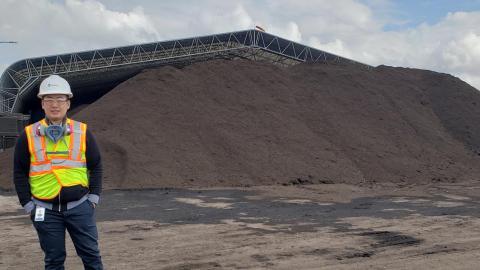
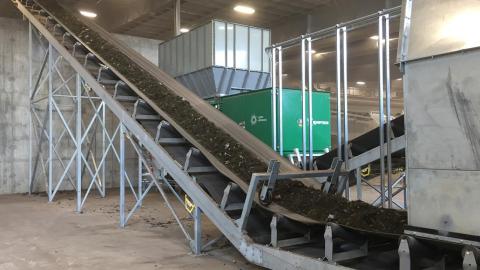
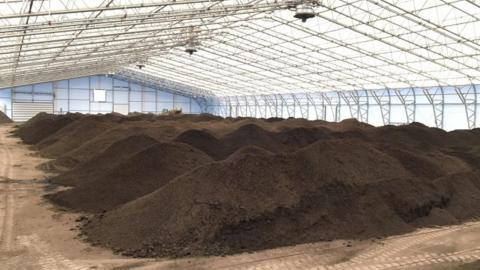
After more than one year of successful operation, the City is again asking ‘what if…’ Considering that the volume of input SSO feedstock has been consistently over the predicted amounts, soon the City will be evaluating their options regarding the expansion of the Calgary Composting Facility. Expansion was expected at some point the future, but it may be feasible sooner than originally anticipated due to outstanding public acceptance of the City’s Green Cart and Yard Waste program.
In 2019, the City started a series of condition assessments of the facility and its major processing elements. The ongoing review process will assure that this valuable community asset will be properly maintained and operated for the benefit of all Calgarians.
In 2012, the City of Calgary selected Jacobs to assist in building their new organic waste management campus to handle source-separated residential and commercial organic solid wastes as well as wastewater treatment biosolids. The scope of this project included evaluating cutting-edge technologies, including feedstock processing and composting technologies, and evaluating how to integrate wastewater biosolids with solid waste organics in the same facility. We also provided a market analysis for the sale and development of compost products.
Opened for operations in July 2017, the Calgary Composting Facility consists of three buildings, totaling 521,000 square feet, including a LEEDS V.4 Gold Certified Administration building. It is the largest facility in Canada to use in-vessel composting technology where internal temperature, moisture and aeration of the container are controlled to ensure that no leachate or odor is produced. According to the City’s Organics Program Manager, Craig More, high-quality compost that is ready for lab testing can be created in as little as 60 days, which is impressive when one considers that other composters using only a traditional windrow system, can generally achieve finished, saleable high-quality compost product in about six months or more.
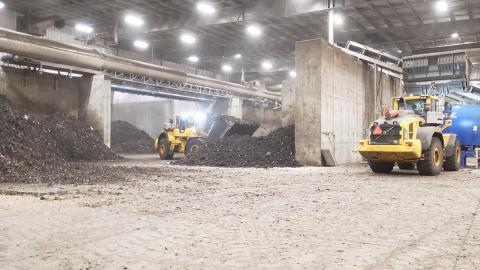
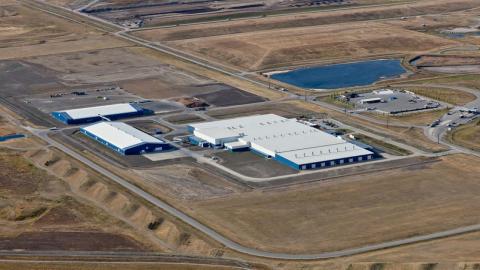
Laura Hamilton, Waste Diversion Specialist with the City of Calgary, explained that since their Green Cart Food and Yard Waste program was implemented in 2017 as part of the organic waste strategy, city waste sent to landfill from single family homes has declined by 46%. She adds that the City is committed to a diversion target that encompasses all waste generating sectors, and they are steadily moving toward a goal of diverting 70% of waste from landfill by 2025. "For 2018, the City diverted approximately 60% of waste in its residential cart collection program, through a combination of blue cart recycling and green cart composting," she said.
After one year of operation, the facility processed over 100,000 tons of source-separated organics (SSO) – a combination of standard food waste and leaf and yard materials – an optimization that achieved the projected outcomes for year 10 in just 1, based on current operating practices and daily production performance. Composting of de-watered biosolids, sourced from Calgary's Bonnybrook Wastewater Treatment Plant, allows the facility to operate near full capacity year-round, minimizing under-utilized capacity over the winter months when green cart tonnages drop significantly.
The Calgary Composting Facility produces a Category A compost from green cart material that is safe to use anywhere, including farms, gardens, parks and nurseries. Compost from biosolids also typically meets Category A criteria. Additionally, a high-nitrogen-based Ammonia Sulphate Powder product is currently being produced with a go-to-market strategy planned for 2019.
Calgary's finished product is measured to the highest industry and regulatory standards, including voluntary participation in the Compost Council of Canada's Compost Quality Alliance. Ken Kielly, Head of Corporate Operations for AIM Environmental Group and General Manager for the Calgary Composting Facility, explained that once compost has gone through both the in-vessel and curing stages, the third stage is laboratory testing and certification. "At that point we take specific samples from every windrow or product produced and it is sent to a certification lab in Ontario. We go through a number of specific testing parameters, and about 30 days later, that product receives a certification to be sold as a finished compost product."